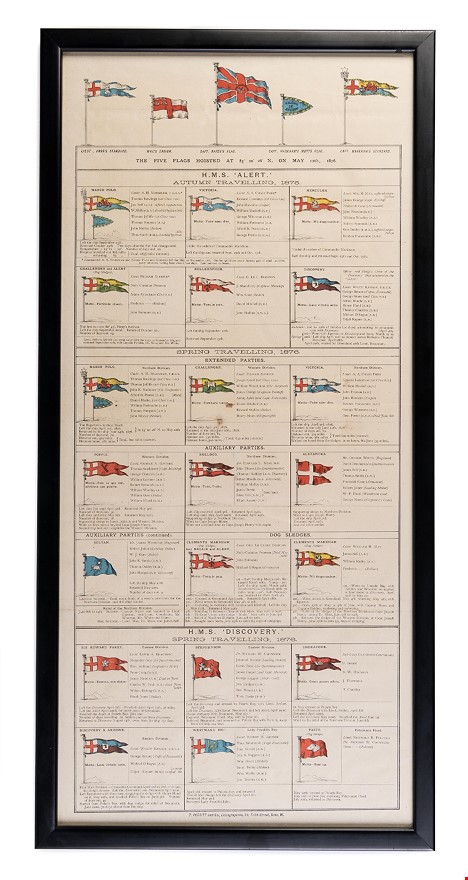The five flags hoisted at 80° 20'26'N. on May 12th, 1876.
BRITISH ARCTIC EXPEDITION, 1875-76. ([1876].)
£3250.00
Please contact us in advance if you would like to view this book at our Curzon Street shop.
HERALDRY FOR POLAR EXPLORERS
Lithographed broadside, flags printed in colour. 310 by 635mm. Framed and glazed with plexiglass. London, Pettitt and Co., Lithographers, n.d. but
The British Arctic Expedition 1875-76 was dispatched in H.M.S. Alert and Discovery under the command of Captain George Strong Nares, with the aim of reaching the North Pole. It did not succeed in this objective, though much important scientific data was gathered and a new furthest North record was set. This unusual lithographic broadside commemorates that achievement, and showcases the individual flags specific to each sledging team on the expedition, providing detailed information about each sledge party's members, movements and ailments or fatalities.
The table is surmounted with the five flags hoisted on May 12th 1876 at the new northernmost point of 83°20'26". These comprise the motto flag and standard of Captain Albert H. Markham (the commander of the sledging party), the standard of Lieutenant A. A. Chase Parr, the flag of Captain Nares (not present for this part of the expedition), and the white ensign, bearing the Union Jack at the hoist of a St George's Cross. The rest of the table gives the individual achievements of each sledging party, with the ailments suffered by crew members in italics beside their names. For example, Captain Markham's sledge Marco Polo's team included a "Jas. Self (A.B.), suffered amputation" and a "W. Malley (A.B.), disabled by frostbite". These notes highlight not only the harsh reality of the physical toll which man-hauling sledges had on men in the high Arctic, but also underlines two of the major set backs of the expedition overall, specifically – and despite the otherwise lavish expenditure – inadequate clothing for the freezing temperatures, and poor quality canned foods purchased by the Navy which contained insufficient vitamin C to ward of scurvy. Liet. Lewis A. Beaumont in particular had a harrowing journey across the wastes of northwestern Greenland with the H.M.S. Discovery Spring Travelling parties of 1876, losing several members of his party.
The introduction of personalised flags for Arctic expeditions dated back to the silk boat ensigns on Parry's 1827 attempt at the North Pole, though the tradition was honed through the mid-nineteenth century with the dozens of ships sent in search of Sir John Franklin's lost 1845 expedition. In particular, Clements Markham had taken a keen interest in them whilst on Captain Horatio Austin's search party in HMS Resolute. His personal enthusiasm for genealogy and heraldry meant that as the Honorary Secretary of the Royal Geographical Society and an experienced consultant in the planning of the British Arctic Expedition 1875-76, he had the freedom to redesign the sledging flags after his preferred model of medieval standards. The majority of the flags on this broadside therefore follow his design - the cross of St George at the hoist to affirm that each bearer was first and foremost an Englishman, then the swallow-tailed fly showing the colours and heraldic arms or crest of the bearer's family. The broadside also records the motto for each flag, not always present in the actual design.
Cf. Howgego III N6; Tomlinson, Barbara, Chivalry at the Poles: British Sledge Flags.
Stock Code: 228932




